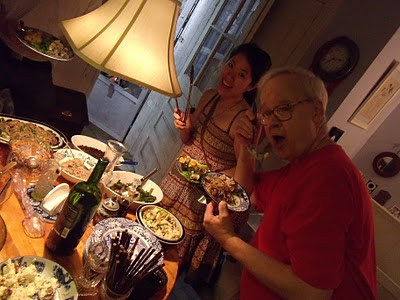 Some post-screening reflections on exquisite corpse curating. On Saturday Kevin Duggan and I presented our screening at Union Docs made up of films selected from The Film-Makers' Cooperative, and curated as an exquisite corpse. Each of us selecting a film in response to the previous film selected by the other. The premise was not to curate in the manner of having a theme, but to let the exquisite corpse travel on its own path, ending up where neither of us could anticipate it would take us.
Some post-screening reflections on exquisite corpse curating. On Saturday Kevin Duggan and I presented our screening at Union Docs made up of films selected from The Film-Makers' Cooperative, and curated as an exquisite corpse. Each of us selecting a film in response to the previous film selected by the other. The premise was not to curate in the manner of having a theme, but to let the exquisite corpse travel on its own path, ending up where neither of us could anticipate it would take us. ***
***In keeping with the exquisite corpse aspect we kept the actual program secret up until the show. But now we can let the cat out of the bag:
Rudy Burckhardt
Eastside Summer (1959) 16mm, color, sound, 11 min
 selected by Kevin
selected by KevinSeth Mitter
Beard St (2007) 16mm, color, silent, 3 min
selected by Joel
James Benning
Chicago Loop (1976) 16mm, color, sound, 8.5 min
selected by Kevin (originally was to have been Brahkage & Cornell's Gnir Rednow, but it wasn't available)
Michael Snow
Standard Time (1967) 16mm, color, sound, 8 min
selected by Joel
Marie Menken
Lights (1966) 16mm, color, silent, 6 min
selected by Kevin
Florens Fanciulli
Giro Giro Tondo (2007), 16mm, color, sound 3 min.
selected by Joel
Robert Breer
Fuji (1973) 16mm, color, sound, 8.5 min
selected by Kevin (originally was to have been Harry Smith's Mirror Animations, but it was already rented out)
Martha Colburn
Cats Amoré (2001) 16mm, color, sound, 2.5 min
selected by Joel
The exquisite corpse going from: lyrical city portrait; to structuralist city portrait; to structuralist camera use of movement; to lyrical use of camera movement; to experimental animation.
***
In retrospect the most interesting part of the experience was the degree to which it was necessary to proactively fight against having the exquisite corpse slip into a thematic program. The rudder had to be pushed to keep from just sailing along in a straight line. The uncharted direction characteristic of the exquisite corpse wasn't just something that wanted to happen on its own. In fact, a large part of selecting works turned out to be the negative process of what not to select: After starting with a few city portraits and films about urban landscape it would have been very easy to keep moving in that direction (Marie Menken's Go Go Go, Dominic Angerame's city symphony films). This would have been a very acceptable thematically contained program of films about The City, but certainly not a true exquisite corpse. None of the unexpected lurching moves from one thing to another. In a curious way it was more challenging to program a "theme-less" exquisite corpse program than opting for a curatorial theme; for instance if Kevin and I had just said, "Let's do a program all about camera movement," or something like that.
***
But now wondering about the many possible approaches to experimental curating. The exquisite corpse; the use of parameters (all films with the word "red" in the title, or all films one minute long) to connect disparate works; processes of audience selection; multiple people bringing films in a "salon" style program; or even the total multiple projection mash-up as an act of experimental curating. Here's to the possibilities!
Cheers!

















